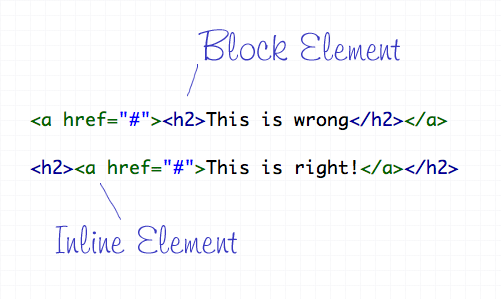英文叫做 “Block-level” links,我以为只有我厂那些鸟毛不知道,没想到不知道的还挺多,需要普及一下。
最近看了 kejun 的 PPT 前端开发理论热点面对面:从怎么看,到怎么做?,p21 引用了 10 HTML Tag Crimes You Really Shouldn’t Commit 中的一条:

很遗憾,Web 标准中处处充满了打脸行为,这条规则现在已经失效了!在那篇文章发布一个月后,HTML5doctor 发表了 “Block-level” links in HTML5,引述一下,就是原先你要这么写:
<div class="story">
<h3><a href="story1.html">Bruce Lawson voted sexiest man on Earth</a></h3>
<p><a href="story1.html"><img src="bruce.jpg" alt="full story. " />A congress representing all the planet's women unanimously voted Bruce Lawson as sexiest man alive.</a></p>
<p><a href="story1.html">Read more</a></p>
</div>
现在 HTML5 中可以这么写
<article>
<a href="story1.html">
<h3>Bruce Lawson voted sexiest man on Earth</h3>
<p><img src="bruce.jpg" alt="gorgeous lovebundle. ">A congress representing all the planet's women unanimously voted Bruce Lawson as sexiest man alive.</p>
<p>Read more</p>
</a>
</article>
从无障碍角度考虑仅仅增加了图片的 alt 描述文字(为读屏用户提供更详细的信息),而不需人为的制造辣么多个“冗余”的 a!HTML5 的思想中的一条就是务实,用现在的话说就是接地气,嗯哼~
虽然这种写法不向前兼容,但经过 HTML5 doctor 的测试表明,主流浏览器都支持,也就是说:
你和你的小伙伴们现在就可以在项目中使用啦!
为了兼容 IE6/7 的手型 bug,需要在 reset.css 中加入诸如这样的代码:
a div, a h3, a p, ...{#cursor:hand}